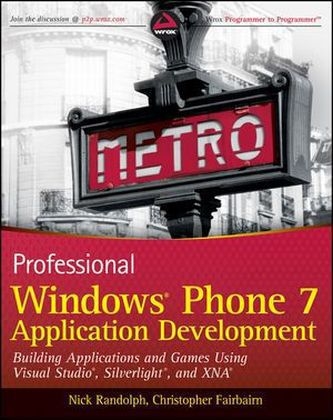
Professional Windows Phone 7 Application Development
Wrox Press (Verlag)
978-0-470-89166-7 (ISBN)
- Titel ist leider vergriffen;
keine Neuauflage - Artikel merken
Nick Randolph is a Microsoft MVP in Device Application Development, and a solutions architect at Built To Roam, where he builds rich mobile applications. He is also the author of Professional Visual Studio 2008 and Professional Visual Studio 2010. Christopher Fairbairn is a Microsoft MVP in Device Application Development and has developed custom solutions and commercial products for platforms including Palm OS, Windows Mobile, iPhone, and J2ME.
INTRODUCTION xxv CHAPTER 1: TAKING THE METRO WITH WINDOWS PHONE 1 Minimum Specifications 2 Chassis Design 3 Screen Resolution 5 Metro Design Language 5 Principles 7 User Experience 8 Start and Lock Screens 9 Hubs 10 Developer Landscape 12 Summary 13 CHAPTER 2: FREE TRANSPORT WITH VISUAL STUDIO 2010 AND EXPRESSION BLEND 4 15 Visual Studio 2010 Express for Windows Phone 16 Expression Blend 4 21 Windows Phone Emulator 24 Summary 26 CHAPTER 3: DESIGNING LAYOUTS USING RED THREADS 27 Red Threads 27 Controls 29 Standard Controls 34 Layout 50 Resources and Styles 54 Themes 59 Summary 61 CHAPTER 4: ADDING MOTION 63 Visual State Management 63 Behaviors 71 Animation 79 Template Transitions 80 State Transitions 83 Panoramic and Pivot Controls 88 Summary 94 CHAPTER 5: ORIENTATION AND OVERLAYS 95 Device Orientation 95 Orientation Detection 96 Orientation Changes 99 Orientation Strategies 99 Soft Input Panel (SIP) 109 Application Bar 113 Icon Buttons 114 Menu Items 118 Opacity 119 State Changed Event 120 System Tray 120 Summary 121 CHAPTER 6: NAVIGATION 123 Page Layout and Architecture 123 Navigation 126 Fragments and QueryString 131 UriMapping 132 Go Back 133 GoBack and CanGoBack 135 Animation 136 Wizards 139 Background Processing 140 Eligible for Termination 141 Scenarios 142 Saving State 146 Obscured 148 Summary 149 CHAPTER 7: APPLICATION TILES AND NOTIFICATION 151 Application Tile 151 Push Notifications 155 Priority 161 Tile Notifications 163 Toast Notifications 164 Raw Notifications 165 Examples 166 Errors 169 Summary 171 CHAPTER 8: TASKS 173 Windows Phone Tasks 173 Where Did My Application Go? 175 Camera and Photos 176 Phone and SMS 179 E-Mail 184 Launchers 188 Extras 192 Summary 194 CHAPTER 9: TOUCH INPUT 195 User Experience 195 Guidelines 196 Touch Events 200 Single Touch 201 Double-Tap 203 Multi-Touch 214 Summary 220 CHAPTER 10: SHAKE, RATTLE, AND VIBRATE 221 Accelerometer 221 Working with the Emulator 226 Reactive Extensions for .NET 238 Vibration 239 Summary 240 CHAPTER 11: WHO SAID THAT? 241 Media Playback 241 MediaElement 241 SoundEffects with XNA 257 Microsoft Translator 267 Audio Recording 270 Playback 272 Saving 272 Music and Video Hub 274 FM Tuner 276 Summary 278 CHAPTER 12: WHERE AM I? FINDING YOUR WAY 279 Geo-Location 279 GeoCoordinateWatcher 280 IGeoPositionWatcher 284 Bing Maps 295 Map Design 296 Map Credentials 297 Points of Interest and Lines 298 Events 302 Bing Maps Web Services 304 Summary 307 CHAPTER 13: CONNECTIVITY AND THE WEB 309 Connected Status 309 Network Availability 310 Service Reachability 310 Emulator Testing 312 Connectivity 315 WebBrowser Control 320 MultiScaleImage 326 Authentication 328 Windows Live ID 329 Summary 347 CHAPTER 14: CONSUMING THE CLOUD 349 HTTP Request 349 WebClient 350 HttpWebRequest 355 Credentials 359 Compression 360 WCF/ASMX Services 365 Service Configuration 365 Add Service Reference 367 Service Implementation and Execution 368 Custom Headers 371 Credentials 371 WCF Data Services 372 OData with WCF Data Services 372 JSON 379 Summary 383 CHAPTER 15: DATA VISUALIZATION 385 Data Binding 385 DataContext 386 BindingMode 388 Value Converters 392 Designing with Data 394 Sample Data 394 Design-Time Data 402 MVVM Light Toolkit 411 Element and Resource Binding 413 Summary 415 CHAPTER 16: STORING AND SYNCHRONIZING DATA 417 Isolated Storage 417 ApplicationSettings 418 IsolatedStorageFileStream 421 Data-Caching 422 Object Cache 422 Persistent Storage 430 Synchronization 442 Summary 458 CHAPTER 17: FRAMEWORKS 459 Managed Extensibility Framework 459 Import and Export 460 ImportMany 463 Application Composition 467 Microsoft Silverlight Analytics Framework 467 Testing 471 Unit Testing 471 Emulator Automation 486 Summary 490 CHAPTER 18: SECURITY 491 On the Device 491 Device Security 492 Device Management 492 Data Encryption 493 Over the Wire 496 Transport 496 Authentication 497 Summary 514 CHAPTER 19: GAMING WITH XNA 515 Getting Started 515 Game Loop 521 Game Life Cycle 522 Rendering 524 Content 524 Sprites 525 Movement 526 Text and Fonts 527 Input 530 Accelerometer 530 Touch 531 Keyboard 532 3D Rendering 532 3D Model 533 Color and Lighting 535 Primitives 535 Textures 538 Summary 539 CHAPTER 20: WHERE TO NEXT? 541 Device Debugging 541 Registering for Development 541 Debugging Applications 543 Deploying Applications 544 Third-Party Components 544 Silverlight Toolkit 545 Database 546 Application Migration 547 User Interface 547 Services and Connectivity 548 Data 548 Device Capabilities 548 Background Processing 549 User Interface Performance 549 Performance Counters 549 Redraw Regions 551 Caching 551 External Systems 552 Proxy Service (Exchange) 552 Shared Key Signatures (Windows Azure) 554 Publishing 563 Application and Start Icons 564 Splash Screen 565 Capabilities 565 Trial Mode and Marketplace 567 Summary 569 INDEX 571
| Erscheint lt. Verlag | 9.11.2010 |
|---|---|
| Reihe/Serie | Wrox Programmer to Programmer |
| Zusatzinfo | Illustrations |
| Sprache | englisch |
| Maße | 191 x 235 mm |
| Gewicht | 1046 g |
| Einbandart | Paperback |
| Themenwelt | Sachbuch/Ratgeber ► Natur / Technik |
| Mathematik / Informatik ► Informatik ► Betriebssysteme / Server | |
| Informatik ► Software Entwicklung ► Mobile- / App-Entwicklung | |
| Informatik ► Weitere Themen ► Smartphones / Tablets | |
| Technik ► Elektrotechnik / Energietechnik | |
| ISBN-10 | 0-470-89166-1 / 0470891661 |
| ISBN-13 | 978-0-470-89166-7 / 9780470891667 |
| Zustand | Neuware |
| Haben Sie eine Frage zum Produkt? |
aus dem Bereich


